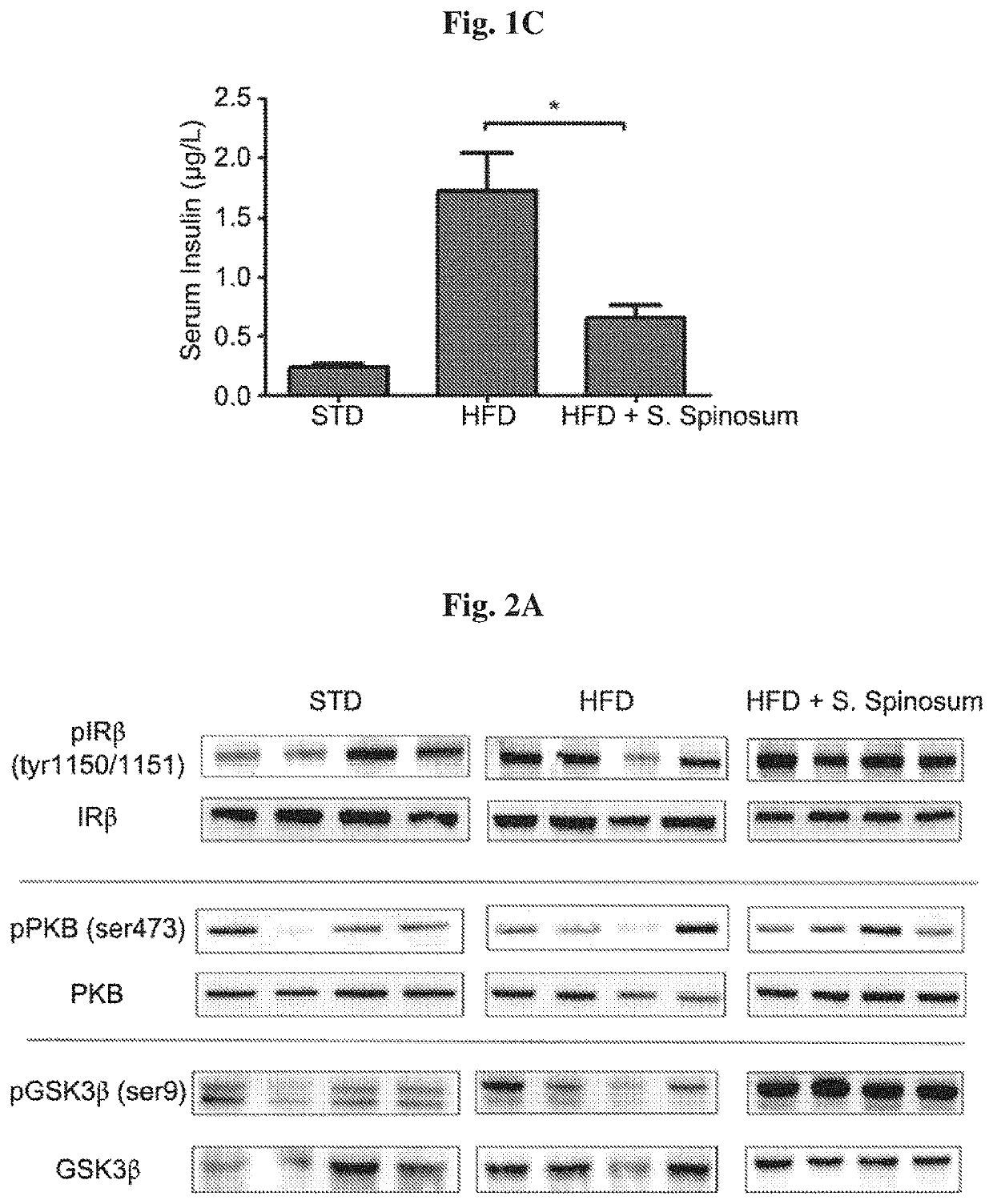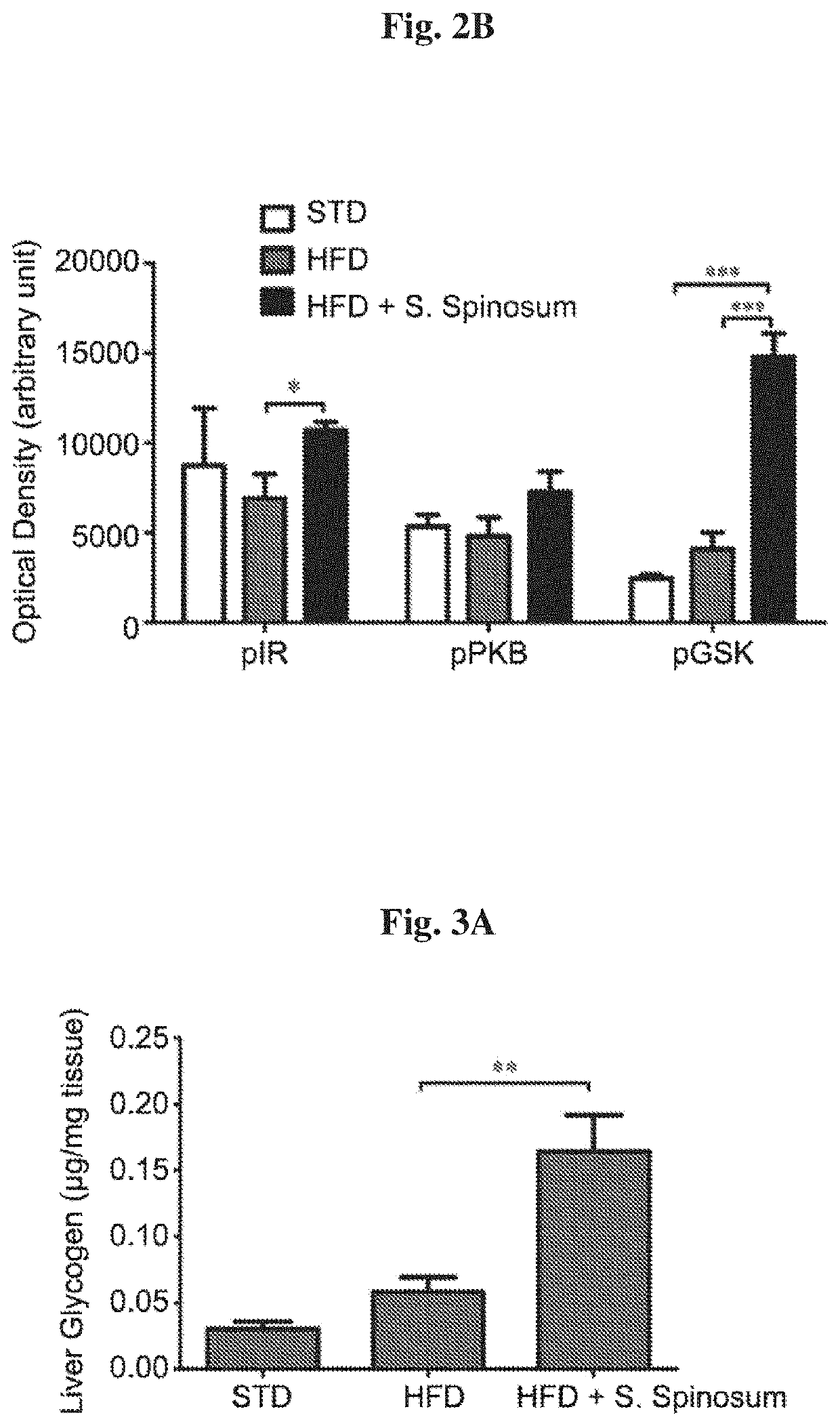S. spinosum extract for treating fatty liver disease
- Summary
- Abstract
- Description
- Claims
- Application Information
AI Technical Summary
Benefits of technology
Problems solved by technology
Method used
Image
Examples
example 1
The Effect of S. spinosum Extract in Solution on a Mouse Model of Steatosis (Prevention Protocol)
[0089]The study was performed on a model of diet-induced glucose intolerance, using high fat diet (HFD)-fed C57bl / 6 mice (HFD, 60% of total calories derived from fatty acids, 18.4% from proteins and 21.3% from carbohydrates, Envigo Teklad diet TD.06414). Six weeks old male mice were separated into 3 treatment groups, 8-10 mice each, as follows: 1) control C57bl / 6 mice fed with standard diet (STD, 18% of total calories derived from fat, 24% from proteins and 58% from carbohydrates. Envigo Teklad diet TD.2018); 2) HFD-fed mice; and 3) HFD-fed mice where the diet was supplemented with S. spinosum extract which was administered daily in the drinking water starting at age of 6 weeks.
[0090]Body weight was measured once a week. At age 16 weeks, mice were anesthetized using ketamine+xylazine and euthanized by terminal bleeding followed by cervical dislocation. Blood was collected from the heart ...
example 2
S. spinosum Improves Glucose Tolerance in High Fat Diet (HFD)-Fed Mice (Prevention Protocol)
[0091]The effects of S. spinosum root extract on body weight and glucose homeostasis was followed. A significant increase in body weight of the HFD-fed groups (FIG. 1A) was demonstrated. Food consumption and drinking habits were measured, demonstrating lower food consumption in HFD-fed groups and no difference between all 3 groups in drinking habits (data not shown). Body weight was higher in HFD-fed mice, with no effect of S. spinosum on the rate of body weight accumulation. Fasting blood glucose and glucose disposal following intraperitoneal glucose load was altered in HFD-fed mice. S. spinosum extract did not affect fasting glucose levels but improved glucose disposal of the HFD-fed mice (FIG. 1B), an effect that is accompanied by reduced fasting serum insulin levels (FIG. 1C). These results suggest a positive effect of S. spinosum extract on HFD-fed mice.
example 3
S. spinosum Improves Insulin Signaling in Liver of HFD-Fed Mice (Prevention Protocol)
[0092]In order to determine whether the improvement in glucose tolerance in glucose intolerant HFD-fed mice is mediated by elevated activation of the insulin signaling cascade, the phosphorylation of key proteins mediating insulin signal transduction was followed in liver (FIG. 2A). A significant increase in insulin-induced phosphorylation of insulin receptor (IR) and GSK-3β in liver of S. spinosum treated, HFD-fed mice was found (FIG. 2B). These findings support the suggestion that S. spinosum extract improved metabolic hepatic function.
PUM
 Login to View More
Login to View More Abstract
Description
Claims
Application Information
 Login to View More
Login to View More - R&D
- Intellectual Property
- Life Sciences
- Materials
- Tech Scout
- Unparalleled Data Quality
- Higher Quality Content
- 60% Fewer Hallucinations
Browse by: Latest US Patents, China's latest patents, Technical Efficacy Thesaurus, Application Domain, Technology Topic, Popular Technical Reports.
© 2025 PatSnap. All rights reserved.Legal|Privacy policy|Modern Slavery Act Transparency Statement|Sitemap|About US| Contact US: help@patsnap.com



